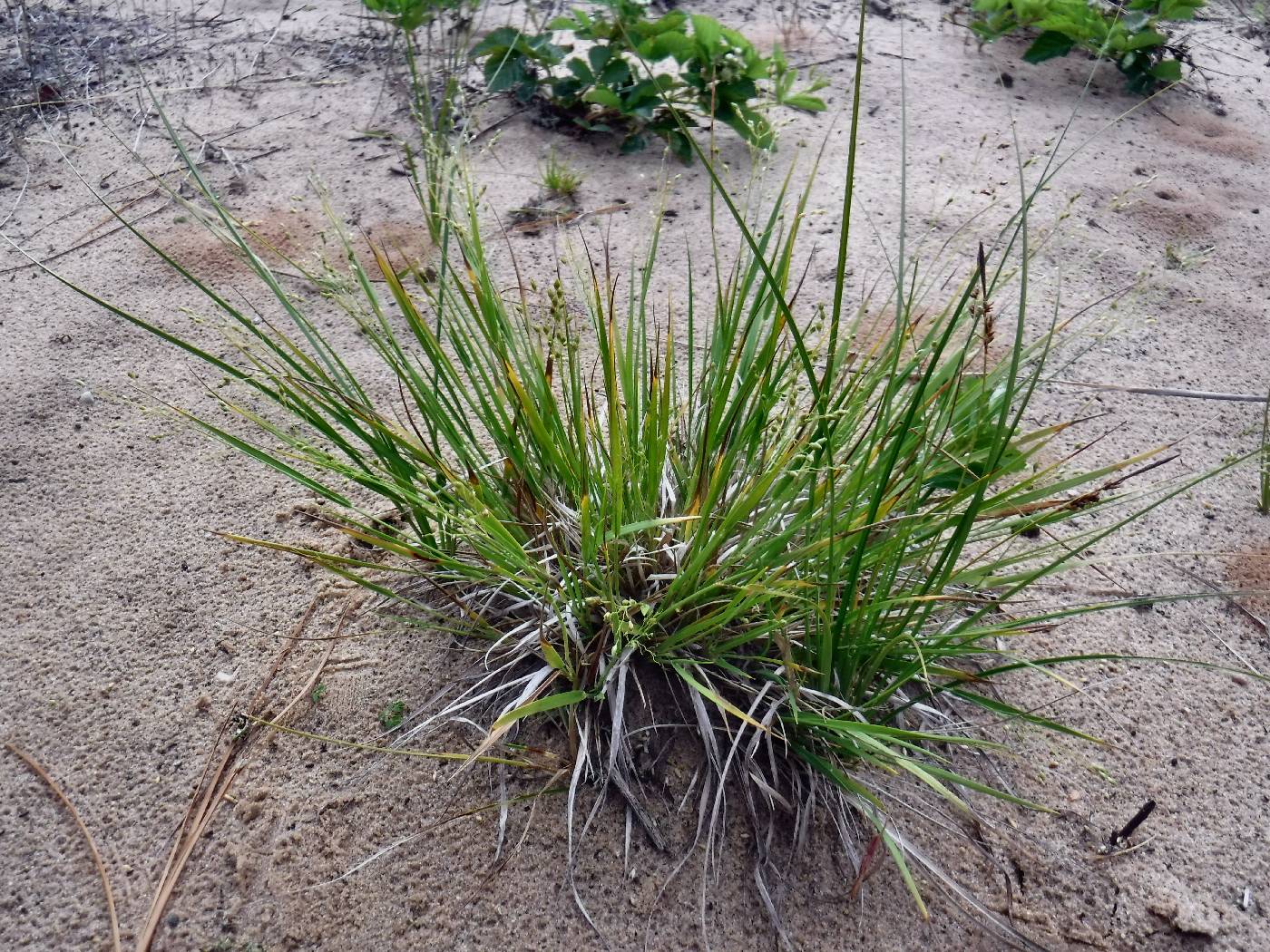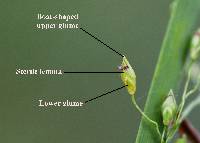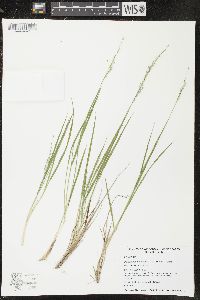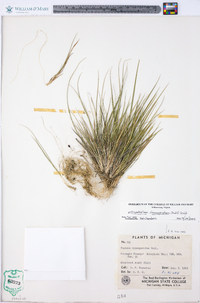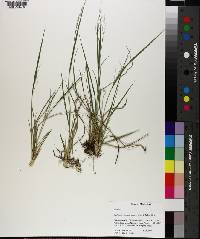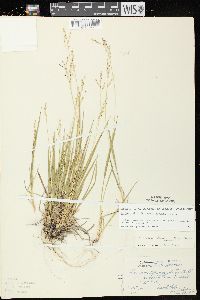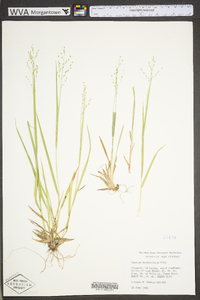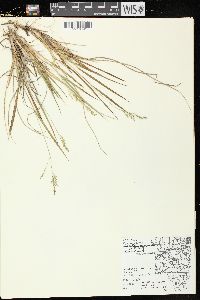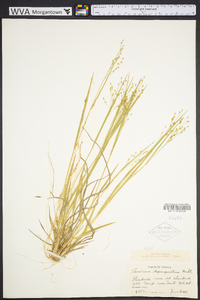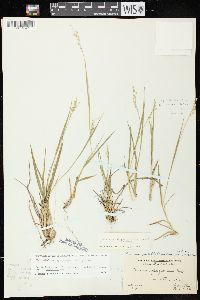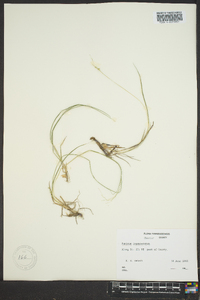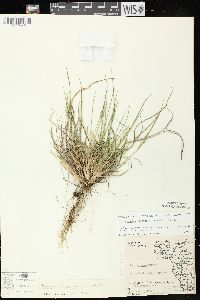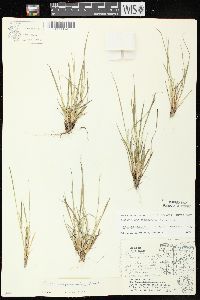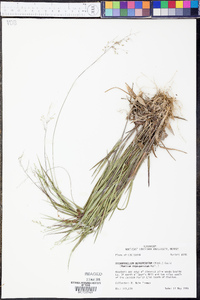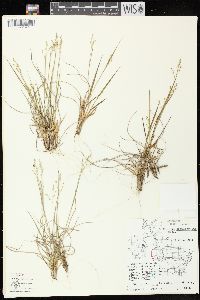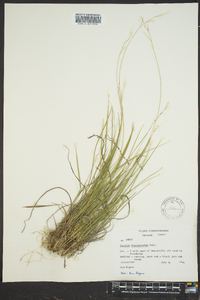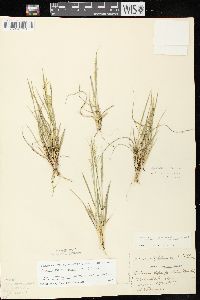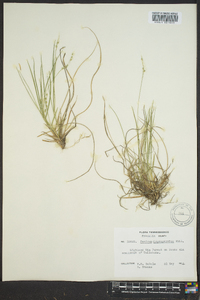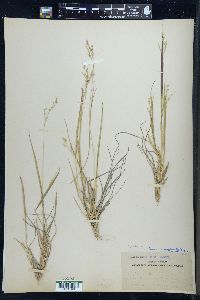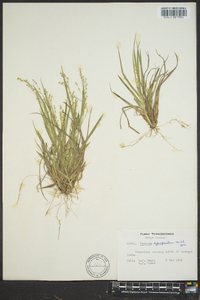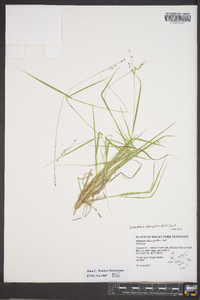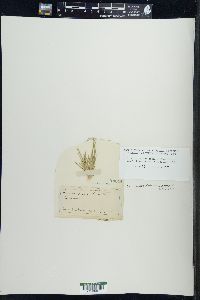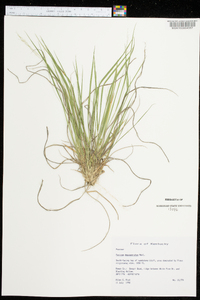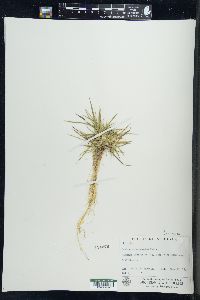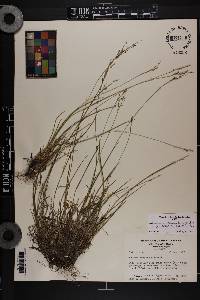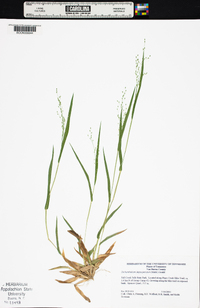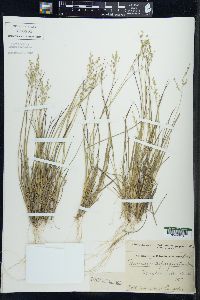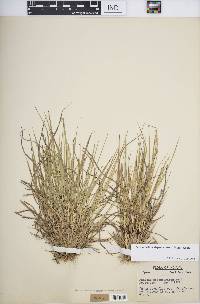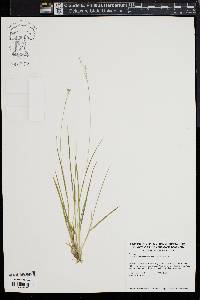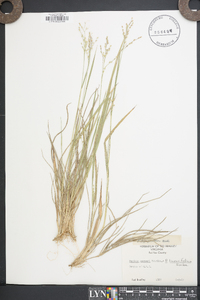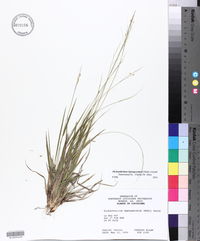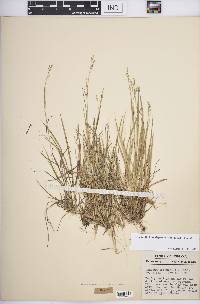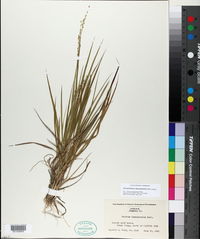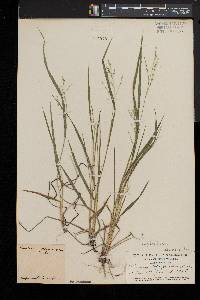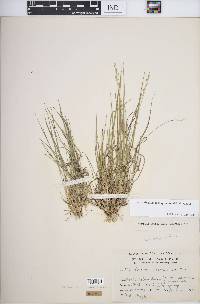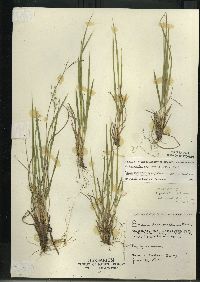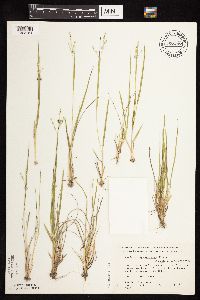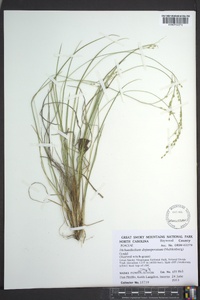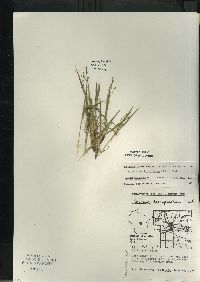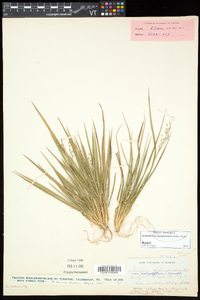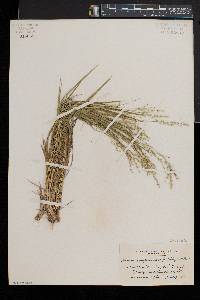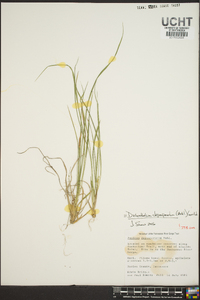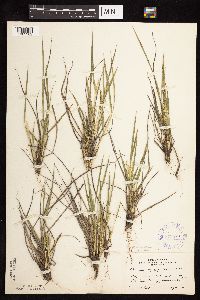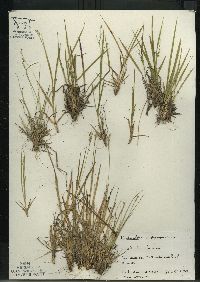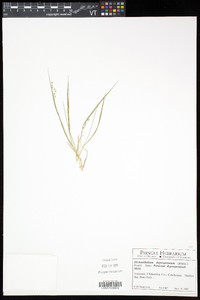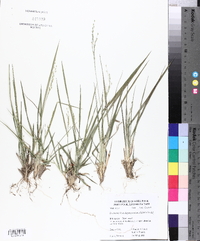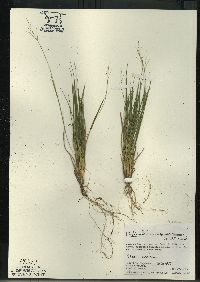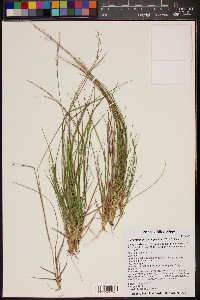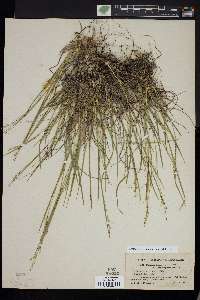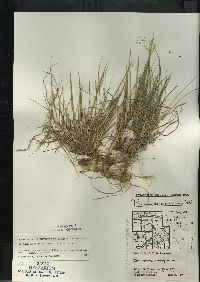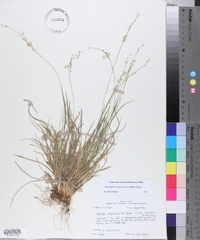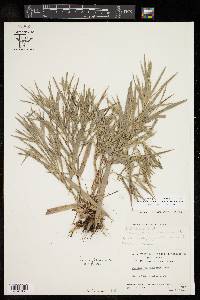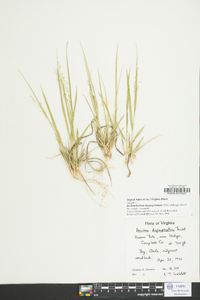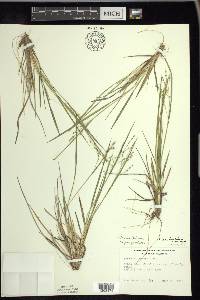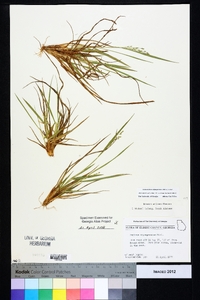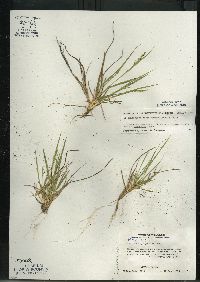
|
|
|
|
Family: Poaceae
starved panicgrass, more...Starved Witch Grass (fr: Panic Appauvri)
[Panicum depauperatum f. cryptostachys Fernald, morePanicum depauperatum f. depauperatum Muhl., Panicum depauperatum f. psilophyllum Fernald, Panicum depauperatum var. laxum Vasey, Panicum involutum Torr., Panicum muhlenbergii Spreng., Panicum rectum Roem. & Schult., Panicum sprengelii Kunth] |
Plants cespitose. Basal rosettes poorly differentiated; blades similar in shape to the lower cauline blades, narrow, ascending. Culms 10-45 cm, erect to spreading, lower 4-10 internodes telescoped together, less than 2 cm, upper 2 internodes elongated; nodes bearded; internodes pubescent to subglabrous; fall phase a dense mass of erect blades and foreshortened branches that arise from the basal culm nodes, about 1/2 of the branches sterile, others with small, narrow, secondary panicles of 3-7 spikelets that remain enclosed within the sheaths. Cauline leaves 2-4; sheaths longer than the internodes, glabrous or densely ascending-pilose; ligules about 0.5 mm; blades 6-15 cm long, 1-4 mm wide, green to grayish-green, sometimes involute, glabrous or densely pilose, apices long-tapering, lower blades small to vestigial, upper 2 or 3 blades longer and stiffly erect. Primary panicles 3-6 cm long, 1.5-3 cm wide, usually long-exserted (sometimes contracted and remaining basal), with 7-25 spikelets. Spikelets 3.2-4.3 mm long, 1-1.7 mm wide, ellipsoid-pointed, glabrous or finely pubescent. Lower glumes 1.2-1.6 mm, narrowly triangular; upper glumes and lower lemmas exceeding the upper florets by 0.2-1 mm, forming a pointed beak, upper florets 1.9-3.1 mm, obovoid, minutely umbonate. 2n = 18. Dichanthelium depauperatum grows in dry, open woodlands and open, disturbed areas, especially on sand. It is restricted to the Flora region. The primary panicles, which are rarely open-pollinated, are produced from May to early June; the secondary, cleistogamous panicles are produced from late June through July (rarely in fall). The species is linked with D. perlongum and D. linearifolium by occasional hybrids and hybrid derivatives. In the northern United States and Canada, 80-90% of the plants are glabrous and have been called Panicum depauperatum var. psilophyllum Fernald, Panicum depauperatum var. involutum (Torr.) Alph. Wood, or, if the primary panicles remain near the base, Panicum depauperatum forma cryptostachys Fernald; in this treatment, none of these are recognized as distinct taxonomic entities. The frequency of pilose plants increases southward, where some populations are entirely pilose. Perennial herb, tufted 10 - 45 cm tall Inflorescence: a terminal, branched arrangement of spikelets (panicle). Primary panicles atop the culms, 3 - 6 cm long, 1.5 - 3 cm wide, usually well-exserted, with seven to twenty-five spikelets. Secondary panicles (when present) atop the branches. Fruit: a caryopsis, indehiscent, enclosed within the persistent lemma and palea. Culm: upright to spreading, 10 - 45 cm long, round in cross-section, hollow, nearly hairless to hairy. Lower internodes much shorter than the elongated upper two internodes. Fall phase a dense mass of upright leaf blades and shortened branches, arising from the basal nodes, producing sterile shoots and small secondary panicles which remain within the sheaths. Spikelets: 3 - 4.5 mm long, 1 - 1.5 mm wide, ellipsoid with a pointed apex, sometimes finely hairy. Basal leaves: in a rosette. Blades ascending, narrow, similar in shape to lower stem leaves. Stem leaves: two to four, alternate, two-ranked. Sheaths longer than internodes, sometimes densely soft-hairy. Ligules about 0.5 mm long, composed of hairs. Blades stiff, upright, 6 - 15 cm long, 1 - 4 mm wide, (lower blades small to rudimentary), long-tapering to the tip, parallel-veined, sometimes densely soft-hairy. Glumes:: Lower glumes 1 - 1.5 mm long, narrowly triangular. Upper glumes longer than upper florets by up to 1 mm, forming a beak. Lemmas:: Lower lemmas similar to upper glumes, longer than upper florets by up to 1 mm, forming a beak. Upper lemmas longitudinally lined, shiny, with rolled-up margins above. Paleas:: Lower paleas shorter than lower lemmas, thin. Upper paleas longitudinally lined. Florets:: Upper florets bisexual, stalkless, 2 - 3 mm long, reverse egg-shaped with a protuberance at the apex, plump. Anthers three. Stigmas red. Similar species: No information at this time. Flowering: late May to late June Habitat and ecology: Frequent in dry sandy Black Oak savannas. It is particularly common in the open sandy areas of the dune region. Occurence in the Chicago region: native Etymology: Dichanthelium comes from the Greek words di, meaning twice, and anth, meaning flowering, referring to plants that may have two flowering periods. Depauperatum means dwarved, starved, or depauperate. Author: The Morton Arboretum From Flora of Indiana (1940) by Charles C. Deam Infrequent in southern Indiana in open woodland on the crests of black oak, black and white oak, and chestnut oak ridges. In the northern part of the state it is local except in the dune area, where it is frequent in very sandy soil on open, wooded dunes or on sandy knolls and ridges. ...... Indiana Coefficient of Conservatism: C = 6 Wetland Indicator Status: n/a |

